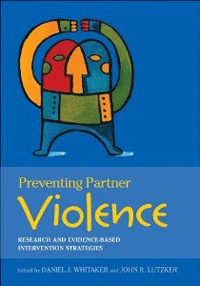Preventing Partner Violence: Research and Evidence-Based Intervention Strategies

“Preventing Partner Violence: Research and Evidence-Based Intervention Strategies”
Edited by Daniel J. Whitaker and John R. Lutzker
American Psychological Association
Washington, D.C., 2009
Book alerts professional community about partner violence
Reviewed By James K. Luiselli, Ed.D., ABPP, BCBA
ntimate partner violence (IPV) is a serious public health problem. Whereas the earliest work on IPV focused on the harmful actions of men towards their female partners, the current clinical and research perspective is broader, including violence committed by women against men, within same-sex relationships and between adolescent partners. IPV remains a complex matter, not easily resolved, but better understood thanks to this well crafted book edited by psychologists Daniel J. Whitaker and John R. Lutzker.
The book has 12 chapters that are presented in three main sections. Section I introduces the dominant theories that account for IPV. Other chapters address risk factors and partner violence outcomes such as child maltreatment and ill health. Equal time is spent on issues that affect both the perpetrators and victims of IPV.
The chapters in Section II concern intervention. As expected, intervention efforts have been multifaceted. They incorporate person-specific therapies, family systems, community programs and legal-criminal justice agencies. Many of these chapters discuss primary and secondary prevention as the critical approach toward IPV.
The third section of the book is a single chapter that summarizes current knowledge and discusses future directions. Practitioners, researchers and policy makers must consider the multiple influences on partner violence in order to reduce prevalence. Some of the issues explored in this chapter are establishing a national surveillance system for identifying IPV, testing empirical models of IPV causation and advancing evidence-based treatments.
The book has numerous strengths, owing to Whitaker and Lutzker’s selection of topics and their careful editing. One way the book succeeds is giving readers important information and a few answers, about basic questions: how prevalent is IPV, how can it be explained, what are the long-term effects? Additionally, the book shows that there is no uniform solution to preventing victimization. The advice given by virtually all of the authors is that rigorous testing of intervention methods is the key to finding meaningful solutions.
“Preventing Partner Violence” would be an ideal text for university courses dealing with public health, community psychology and high-risk clinical conditions. Psychologists and other mental health professionals who work with perpetrators and victims of IPV surely should read the book to be informed about best practices. There is also much to consider for social scientists wanting to conduct studies in an area sorely in need of increased research attention. In summary, the book alerts the professional community to the tragedy of IPV and what has been, can be and should be done to stop it.
James K. Luiselli, Ed.D., ABPP, BCBA, is senior vice president, applied research, clinical training and peer review at the May Institute in Norwood, Mass.
Learn more about the book: Preventing Partner Violence: Research and Evidence-Based Intervention Strategies
